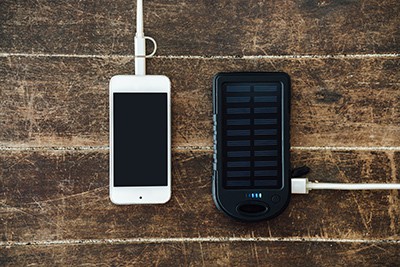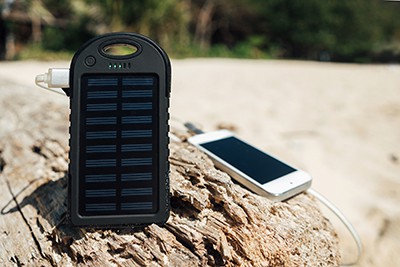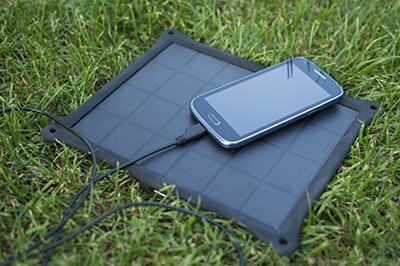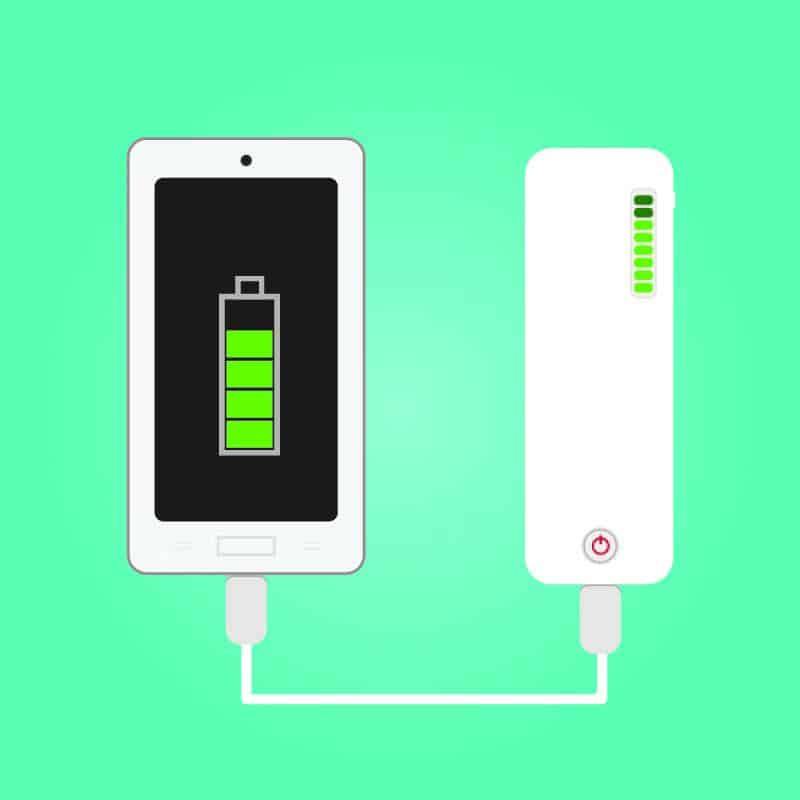Cheaper battery storage allows you to use renewable energy at any time. Whether the sun is shining or the wind is blowing at that particular moment, a full charge can carry you through the day.

One way to keep charged is solar battery chargers. You can use solar charger power for a variety of handheld devices using energy from the sun. After installing a solar panel system, each solar cell will provide power to the solar battery. From there, the solar battery controls the power output to provide maximum power to your home—all while using clean, renewable solar charging technology.
Here are some questions to ask when considering whether to install a solar panel/solar battery system in your home:
- What Is A Solar Battery Charger?
- How Does A Solar Charger Work?
- What Devices Work with a Solar Charger?
- Who Are Solar Battery Chargers Best Suited For?
- What Are The Best Solar Chargers On The Market Today?
- What Other Solar Products Are There?
What Is A Solar Battery Charger?
A solar charger is a device that uses sunlight to generate electricity.

This electricity is then used to charge electrical devices, including cell phones, laptops, car batteries, reading lights, and personal fans. Because these chargers cannot directly expel electricity into the devices, an extended-life battery pack is included in the device. This stores the solar cells’ electricity in the battery, making it available for later using a charging supercapacitor.
The charging supercapacitor is the key to charging devices on-demand, even if the charger is not in direct sunlight at the time of use. These solar chargers range in size from the palm of your hand to the size of a picnic table. They can charge small electric-powered items up to an RV or car battery.
How Does A Solar Charger Work?
A battery charger bank works similarly to a solar photovoltaic system and a more traditional battery bank storage system. First, sunlight strikes the surface of the device. This sunlight is then absorbed by the individual solar cells that make up the solar module.

Next, photons from the sunlight excite the electrons within the material, usually silicon, to create an electric field. This is where the charger’s voltage comes from. This electric field is the force by which electrons travel to a solar battery charger kit. This battery then stores the electricity until you are ready to charge any compatible device.
Next, a charge inverter, which is in charge of switching electricity from direct current (DC) to alternating current (AC), turns the electricity back into a more usable form. Similar to how a solar pool heater uses valves to regulate heated water, inverters direct the flow of usable electricity. It is important to note that certain devices use DC electricity to charge their batteries while other devices primarily use AC electricity. Therefore, some devices do not require a charge inverter.
Finally, the electricity is expelled out of the extended-life battery and poured into an electrical device. Although this process appears to be rather complicated, consumers need nothing more than clear sunlight and a few seconds to see the benefits of these devices.
A good battery operates essentially like a rechargeable battery. It’s similar to the way a car battery stores power until you need it, because a solar charge controller only uses the energy you need. Anything leftover wattage gets stored in the battery bank, where it waits to be used again.
What Devices Work with a Solar Charger?
In theory, you can charge any electrical device using a solar build battery pack, as long as you are willing to wait long enough. It takes time for the charge controller to transmit enough battery voltage to the receiving device. But in practice, only certain devices can charge with a solar charger.
Typically, these devices include but are not limited to:
- Cell phones that are only used once or twice per day.
- Laptops (which may take time to fully charge).
- Vehicle and RV batteries, which can take multiple days to charge.
- Solar chargers work well in conjunction with portable solar panels for RVs, both of which help you get all-natural energy on the go.
- And a variety of other small devices that rely on exclusively electrical power such as a flashlight, a reading light, and personal fans.

Solar rechargeable devices are especially useful when going camping or living an extremely nomadic lifestyle. When you’re on the go, you may not always have an electrical outlet handle. Carrying a separate portable solar battery charger is less efficient than devices whose battery charges replenish themselves.
A peak power supply is ideal for charging any device. This means that the battery within the small solar device is at maximum capacity. This way, it can fully discharge into the device you wish to keep electrified. If you wish to extend batteries’ usable life, you should regularly discharge them completely. Doing this ensures that it can continue to store its rated amount of electricity over time.
The size of the device is important. Given how long it takes to charge vehicle batteries, charging a solar powered generator for home use probably isn’t the best way to go about it. Unless you have a
Finally, it is important to consider how often you use the charged devices. Small solar chargers may not be capable of meeting these more rigorous demands.
Who Are Solar Battery Chargers Best Suited For?
A solar powered battery charger is useful for anyone hoping to charge electrical devices while entirely off the grid.

Small solar energy devices are small enough to be stored and convenient enough to use anywhere that the sun is shining—regardless of how far away you are from civilization. The only determining factor of the charger is usually its size. This determines the rate at which certain electrical devices will charge. If you can wait and use the device once or twice per day, a small handheld battery charger bank may be appropriate. On the other hand, if the device is needed frequently or needs to be charged in a shorter time, the solar battery charger kit should be much larger.
In short, your power bank should be as large as your everyday needs are. Common uses for solar chargers are camping trips, those who choose to live a more nomadic lifestyle out of an RV, or simply those seeking to reduce their carbon footprint without giving up many modern-day amenities.
However, some solar products don’t benefit from the presence of a battery charger. Those with their own power system, such as solar path lights, usually don’t need backup power to light your home at night. You also won’t need chargers to power solar tubes or other natural lighting solutions for your home.
What Are The Best Solar Chargers On The Market Today?
There are a variety of solar chargers and solar charged battery kits on the market today. Each of them serves a specific purpose and can do a variety of things.
Here are some of our favorite solar devices:
-
- Voltaic Systems Amp Solar Charger (Handheld devices)
- NOCO Genius G3500 3.5A UltraSafe Smart 6 volt/12 volt Battery Charger (A solar car battery charger)
- ALLPOWERS 100W Bendable Solar Panel Water Resistant Power Sunpower Solar Charger (RV battery)
- Jetsun Solar Charger 16750mAh Portable Solar Power Bank (For outdoor and all-weather use)
Maximum power is necessary in many cases, so it’s important to recognize each charger’s advantages and disadvantages (power is usually measured in kilowatts and/or volts). Weigh all of your options when purchasing a new build battery pack, such as frequency of use, price, charging speed, and estimated longevity. The needs of every consumer are different, so it would be irresponsible to recommend a single solution for everyone.
Small solar energy chargers are more popular than ever before. Improved manufacturing processes have lowered the price of the technology low enough to make it more available to a larger population. A solar charged battery can provide power in various situations ranging from a fun weekend getaway to emergencies. These devices are expected to increase in popularity as they become cheaper and more efficient. Solar charger power will further improve sustainable practices as its adoption rate increases drastically.
What Other Solar Products Are There?
Solar Windows—Solar windows are panels that look just like windows. They improve on the look of solar panels (which can be clunky and unattractive) and are just as effective. Solar windows attach to almost any window and can help you bring solar energy into the home.
Solar Greenhouse—Just like a regular greenhouse, a solar greenhouse harnesses the sun’s energy and redirects it for home use. But solar greenhouses are safe for plants and cost-effective.
Solar Roof Vents—Did you know that solar roof vents can reduce energy spending by 30 percent? They help keep your attic well-ventilated, which in turn optimizes the money you’re using to heat and cool your home.
Solar Shingles—Solar shingles attach to your roof and seamlessly provide solar power. Not only are they long-lasting and visually appealing, but they require little to no maintenance.
[…] A solar powered battery charger is useful for anyone hoping to charge electrical devices while entirely off the grid. Small solar energy devices are small enough to be stored and convenient enough to use anywhere that the sun is shining—regardless of how far away you are from civilization. via […]